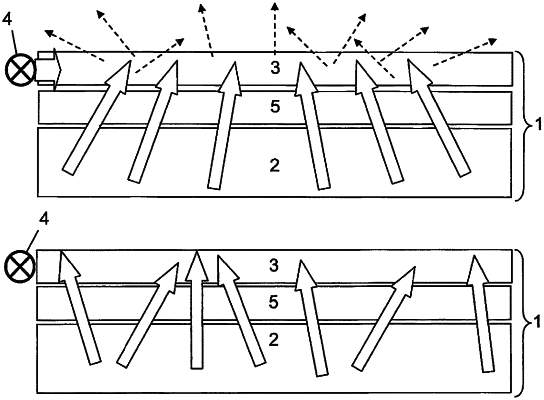| CPC G02F 1/1323 (2013.01) [G02B 6/0041 (2013.01); G02B 6/0065 (2013.01); G02B 6/0076 (2013.01); G02F 1/1336 (2013.01); G02F 1/133502 (2013.01); G02F 1/133616 (2021.01); G02F 1/133626 (2021.01)] | 26 Claims |

|
[ 21. A screen that can be operated in at least two operating modes, viz B1 for a free viewing mode and B2 for a restricted viewing mode, comprising:
a backlight extended in a planar manner that emits light in a restricted angular range, wherein the light originating from the backlight, in at least one direction lying within an angle greater than 45 degrees relative to the surface normal of the backlight, is radiated at no more than 6% of the maximum light intensity, the backlight either being provided with an optical layer that collimates light, or being designed as a collimated backlight, each to achieve a restricted-angle radiation characteristic,
a transmissive imager arranged in front of the backlight as seen in the viewing direction,
at least one plate-shaped light guide located in front of the backlight between the backlight and the transmissive imager as seen in the viewing direction, comprising a thermoplastic or thermoelastic material, and either with scattering particles distributed therein or having outcoupling elements on at least one of its faces, and
light sources being arranged laterally at the edges of the light guide,
wherein, when scattering particles are provided in the light guide, the particles include at least one of titanium dioxide particles, barium sulfate particles, silsesquioxane particles and cross-linked polystyrene particles, of a mean particle size of 150 to 500 nm, which are used in a concentration of 0.01 to 300 wt.-ppm related to the weight of the light guide, and wherein the light guide has nothing printed on it and no light-scattering imperfections,
and wherein:
the light guide is transparent to at least 85% of the light originating from the backlight,
so that, in operating mode B1 for a free viewing range, the light laterally incident from the light sources into the light guide in directions located within angles between 45 degrees and 75 degrees relative to the surface normal of the backlight are radiated at no less than 12% of the maximum light intensity of the light radiated from the light guide normal to the surface,
and so that the light originating from the light sources, when they are switched on, and exiting the light guide from at least one point of its surface, has, in at least one angle α relative to the surface of the light guide, with α<80 degrees, a higher light intensity than the light exiting from the said point of the surface of the light guide normal to that surface,
wherein, in operating mode B2, the backlight is switched on, and the light sources are switched off, and wherein, in operating mode B1, at least the light sources are switched on.]
|